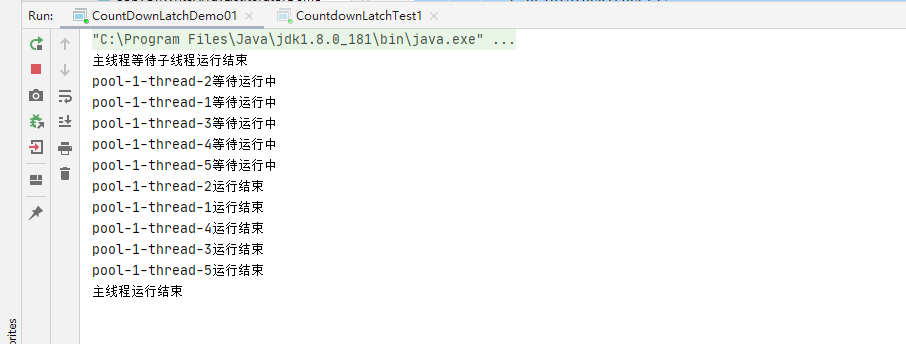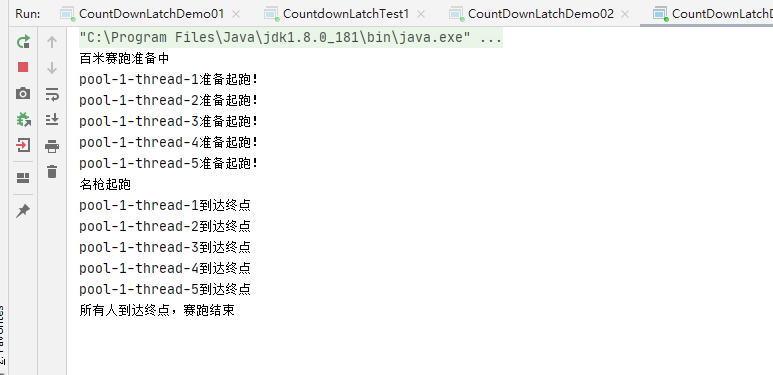概述
本文详细介绍CountDownLatch的两种使用场景,分别是倒数(等待所有的线程处理完成)和唤醒所有线程同时运行(适用于性能测试中触发所有并发同时运行)。
下文从这个两个方面进行介绍
CountDownLatch倒数实例
实例代码利用CountDownLatch的downLatch方法让子线程在运行结束了减2;利用await方法,让主线程阻塞,见下实例代码。
|
1
2
3
4
5
6
7
8
9
10
11
12
13
14
15
16
17
18
19
20
21
22
23
24
25
26
27
28
29
30
31
32
33
34
35
|
package com.yang.concurrent;import java.util.concurrent.CountDownLatch;import java.util.concurrent.ExecutorService;import java.util.concurrent.Executors;public class CountDownLatchDemo01 { public static void main(String[] args) { final CountDownLatch countDownLatch=new CountDownLatch(5); ExecutorService executorService = Executors.newFixedThreadPool(5); for (int i = 0; i < 5; i++) { Runnable runnable = new Runnable() { @Override public void run() { try { System.out.println(Thread.currentThread().getName() + "等待运行中"); Thread.sleep(1000); System.out.println(Thread.currentThread().getName() + "运行结束"); countDownLatch.countDown(); } catch (InterruptedException e) { e.printStackTrace(); } } }; executorService.submit(runnable); } System.out.println("主线程等待子线程运行结束"); try { countDownLatch.await(); } catch (InterruptedException e) { e.printStackTrace(); } System.out.println("主线程运行结束"); }} |
运行结果如下图所示:

CountDownLatch同时运行实例
本实例利用CountDownLatch的await方法让所以的子线程都等待,待相关资源准备好后,主线程通知线程运行。如下实例代码所示:
|
1
2
3
4
5
6
7
8
9
10
11
12
13
14
15
16
17
18
19
20
21
22
23
24
25
26
27
28
29
30
31
32
33
34
35
36
37
38
39
|
package com.yang.concurrent;import java.util.concurrent.CountDownLatch;import java.util.concurrent.ExecutorService;import java.util.concurrent.Executors;/** * 本实例演示子线程都等待 */public class CountDownLatchDemo02 { public static void main(String[] args) { final CountDownLatch countDownLatch=new CountDownLatch(1); ExecutorService executorService = Executors.newFixedThreadPool(5); for (int i = 0; i < 5; i++) { Runnable runnable = new Runnable() { @Override public void run() { try { System.out.println(Thread.currentThread().getName() + "等待运行中"); countDownLatch.await(); System.out.println(Thread.currentThread().getName() + "运行结束"); } catch (InterruptedException e) { e.printStackTrace(); } } }; executorService.submit(runnable); } System.out.println("主线程准备相关资源"); try { Thread.sleep(1000); System.out.println("主线程资源准备就绪,子线程可以运行了"); countDownLatch.countDown(); } catch (InterruptedException e) { e.printStackTrace(); } }} |
运行结果如下图所示:

CountDownLatch赛跑实例
下实例代码我们模拟百米赛跑的故事,赛跑先要进行相关的准备工作,待准备工作完成后,明枪起跑,待所有人都到终点后,起跑结束,相关实例代码如下图所示。
|
1
2
3
4
5
6
7
8
9
10
11
12
13
14
15
16
17
18
19
20
21
22
23
24
25
26
27
28
29
30
31
32
33
34
35
36
37
38
39
40
41
42
43
44
45
46
47
48
49
|
package com.yang.concurrent;import java.util.Random;import java.util.concurrent.CountDownLatch;import java.util.concurrent.ExecutorService;import java.util.concurrent.Executors;/** * 本实例演示子线程都等待 */public class CountDownLatchDemo03 { public static void main(String[] args) { final CountDownLatch beginCountDownLatch=new CountDownLatch(1); final CountDownLatch endCountDownLatch=new CountDownLatch(5); ExecutorService executorService = Executors.newFixedThreadPool(5); System.out.println("百米赛跑准备中"); for (int i = 0; i < 5; i++) { Runnable runnable = new Runnable() { @Override public void run() { try { System.out.println(Thread.currentThread().getName() + "准备起跑!"); beginCountDownLatch.await(); Thread.sleep((long)new Random(1000).nextLong()); System.out.println(Thread.currentThread().getName() + "到达终点"); endCountDownLatch.countDown(); } catch (InterruptedException e) { e.printStackTrace(); } } }; executorService.submit(runnable); } try { Thread.sleep(1000); System.out.println("名枪起跑"); beginCountDownLatch.countDown(); endCountDownLatch.await(); System.out.println("所有人到达终点,赛跑结束"); } catch (InterruptedException e) { e.printStackTrace(); } }} |
运行结果如下:
